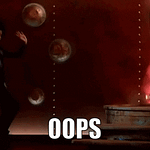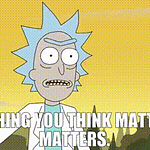
Hi everyone—I’m so glad to have you here. What a week.
There’s a 2013 book by Mark Spitznagel called The Dao of Capital: Austrian Investing in a Distorted World (which I actually wrote about back in 2020 during the early days of this newsletter) where the author makes the case for a “roundabout” way to approach investing. He advocates a strategy, shared by a certain pine tree and by Chinese Taoist philosophical tradition, to opt instead for asymmetric, outsized total returns paid for by a little patience and a tolerance for long stretches of smaller losses. A massive gain one time can pay for a long series of small, but survivable, losses several times over.
The book is philosophical and poetic but mostly very practical, and affected much of my thinking on the topic of risk, and the benefit of a more oblique path to goal achievement.
Last year, Spitznagel released a much more math-heavy take on the subject of wealth preservation called Safe Haven: Investing for Financial Storms, where he challenges some conventional notions of what should be considered “safe” and why it doesn’t always mean the same thing as stable and predictable.
Safe haven investing is about risk mitigation, but it’s not enough to not-lose. Your investments not only have to be cost-effective but they actually have to add economic value over time.
Conventional economic circles (University of Chicago school, etc.) are generally framed around the relationship between risk & return, and posit that to get higher returns you need to put yourself more at risk. Between two investments, you should prefer the one that has the highest expected rate of return but also the lowest rate of volatility. Subsequent principles are then built on this basic assumption or axiom, calculated using something called the Sharpe ratio.
Taking this reasoning to be true creates a mentality that perceives risk-aversion as the way to hedge the performance of a portfolio, and suggests that low volatility is correlated with low risk. That the price of holding “less risky” assets (which are seen to function as “portfolio insurance”) is a lower rate of return.
Spitznagel pushes back on much of this and says no: what you should be trying to do as an investor is maximize how much wealth you have at the end of your chosen time horizon, and that it’s wrong to think of insurance as “playing it safe” if it lowers your overall return at the end.
A smooth ride is not the goal. Or, if it is, you’re on a different kind of journey altogether having more to do with emotional comfort than wealth creation.
If by mitigating risk you’re lowering the long-term compound growth rate of your wealth then you’re doing something wrong. It’s not mitigating your risk if it’s making you poorer. The real risk you should be concerned with is that you will end up poorer at the end.
He’s making a subtle and unconventional point having to do with the difference between geometric vs. arithmetic returns:
Arithmetic mean is calculated as what we traditionally understand to be the “average”: e.g. add up the total return for each investment year and divide by the total number of years.
Geometric mean is a time-weighted rate of return and involves a slightly more complicated equation: you multiply together all the 1+ returns, take the nth root, and then subtract 1
For investors, it’s more accurate to use the geometric mean because this takes into account the total cumulative value of the underlying portfolio. It factors in the compounding effects of a series of volatile returns over time.
However, calculating the geometric mean of a series will always result in a smaller number than calculating its arithmetic mean. Due to this fact, people will typically use the arithmetic mean to try to sell people on an investment because it will always show a higher return compared to its geometric mean counterpart, even though it is not an honest measure of calculating the return on an investment. Be highly skeptical of someone who claims their fund “has an average annual return of x.” Arithmetic mean is not the way.
You should be less interested in the average annual performance of an investment and more interested in its cumulative value at the end. This is why honest investment reports refer instead to a geometric mean calculation that we are all more familiar with: the Compound Annual Growth Rate (CAGR).
Falling prey to arithmetic logic over geometric logic is what happens when you lose sight of the more important whole in favor of a lesser part that is more easy to understand.
It’s no coincidence that the Kelly Criterion is a formula relied upon widely in the world of trading and investing, because it addresses this very tendency. It helps people to determine how much capital to put at risk given the probability of the desired outcome as well as the total amount of capital at risk over an extended period of time into the future. It protects against the fallacy of thinking expected outcome in one instance can be considered separately from cumulative value in all future instances.
The Kelly Criterion shows that if you there’s a bet where when you flip a coin and it comes up heads you get 3x your money but if it comes up tails you lose everything, that if you bet your whole bankroll every round it will actually maximize your arithmetic outcome expectation… however, if you continue playing this strategy you are guaranteed to end up with zero at some point and be forced to stop playing altogether.
It reveals that it’s inaccurate to think of finance as a conflict between maximizing returns and minimizing risk—these are not two opposing extremes. Reality is much more holistic than that, and there’s a certain gestalt that arises from the interplay between the two. Everything is risk mitigation in one sense and growth maximalization in another sense.
Interestingly, the Kelly Criterion formula was created by John Kelly at Bell Labs in 1956 not directly as a solution to betting or gambling but as part of his work on information theory. It was initially formulated to determine thresholds of signal degradation in a radio transmission, and how much distortion could be tolerated in a medium without corrupting the message. (The topic has as much to do with money as it does with technology.)
Anyway, a key takeaway with all this is: you’re engaging in risk management all the time.
Risk does not lie in discrete, static things but is instead a continuous, dynamic process.
You can’t buy a “risky” asset for awhile and then sell and go back to being less risky. You can never sit on the sidelines and not engage in risk. You always take your cumulative returns with you—your bank balance has to go somewhere:
You could put it in U.S. Treasuries—the so-called “risk-free” rate—but that operates on the assumption that the U.S. government will never default on its debts in your lifetime, and also that the interest rate they’re giving you will outpace the rate of inflation.
You could put it in a total stock market or a global stock index fund, but that assumes there will be no more global crises or catastrophic financial contagion effects with incompetent central bank monetary policies like we saw during the 2008 financial crisis.
You could put it in bonds, which are traditionally been considered low-risk, but those now have negligible real yields (even the high-risk junk bonds) and in some cases negative yields 🤡
You could put cash under your mattress, but someone could always break into your house and steal it, or your house could burn down.
You could leave it in cash in your bank account but that still means it’s subject to inflation, which by reported figures is currently at 7% in the U.S., but in real terms is more like 15%. So simply by not taking the “risk” of investing at all, your money is guaranteed to lose 15% of its purchasing power each year.
You could buy gold, which typically does well during inflation years but over the past 2 years has actually performed horribly. Gold’s performance over long periods of time looks okay, but only arithmetically (% gains per year). If you’re in the wrong decade, like right now, you’re doing quite poorly. (You also have to hope the government doesn’t confiscate it from you again)
You could buy Bitcoin, something that I do, but many people don’t because they see it as a nascent, complicated, unproven technology that will be replaced or forbidden and is, therefore, in their assessment, “too risky.”
People think they can selectively engage in risk, but the truth—the reality—is that you are participating in a larger system, bound up in the collective whole of relationships and exchanges, and the best you can do is try to keep growing while avoiding ruin at all times.
The more you accumulate—the more your wealth or knowledge or relationships compound—the more value you have at risk. You cannot think about a year of returns in isolation, you have to account for the fact that the amount consists of everything you’ve managed to attain up to that point. Risk and Reward are not two sides of a spectrum you can dial up or down, they are two sides of the same coin.
This tension is the same duality explored by philosophies and religions through the ages, both East and West, as they all are engaged in trying to apprehend the true nature of reality.
The duality also reflects both sides of the human mind: one side that compartmentalizes and categorizes, and the other that deals in sense-making and higher order synthesis:


This yin and yang is also present in our political systems, with one extreme being liberals who operate in a mindset of “liberating” and untethering things from systems in an effort to expand future possibilities, and the other extreme being conservatives who are more interested in “conserving” systems that provide a sense of stability and a way to compartmentalize things to make them more tractable, reliable, and orderly.
Conservatives tend to oppose change, while liberals tend to oppose stasis.
The interaction between the two is The Way.


The human condition is this: nobody can be certain of anything but we all have to make decisions anyway. And the criteria we use to make our decisions depends upon our framework for understanding how reality works and why things behave the way they do.
Choose the wrong framework, and you’re likely to end up on the wrong path going the wrong Way.
Until next time 🤙,
Recommended Resources For Plan ₿
Swan. I became an official Swan partner because I love them so much. So if you're like me and just want an easy, automated way to buy bitcoin on the regular with the lowest fees in the game, head to https://swanbitcoin.com/Mulvey to get $10 in bitcoin for free ✨
Fold Card. Earn bitcoin on everything. You can win up to 100% back on every purchase, and every swipe is a chance to win a whole bitcoin. I use my own Fold card to pay for almost literally everything. If you use this referral link you get 5,000 sats free ✨













